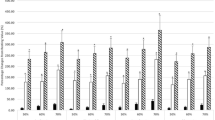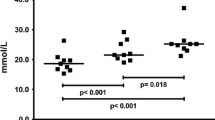Abstract
The effects of strenuous physical exercise on the serial changes in the haematological, biochemical and hormonal markers were investigated. A group of 14 soldiers, aged 24–36 years, took part in a military training course for about 13 weeks. After severe exercise stress, an increase (90%) in the number of peripheral blood leucocytes was observed. The degree of leucocytosis showed a close correlation with the values of some serum parameters, such as concentrations of aspartate aminotransferase (AST;r = 0.747), lactate dehydrogenase (LD;r = 0.748), blood urea nitrogen (r = 0.756), creatine kinase (CK;r = 0.637), manganese-superoxide dismutase (Mn-SOD;r = 0.508), alanine aminotransferase (ALT;r = 0.542) and uric acid (r = 0.538), and concentrations of urinary parameters, such as vanilmandelic acid (r = 0.429) and free cortisol (r = 0.437). The subjects showing prominent leucocytosis over 9500 cells · μl−1 exhibited a lower concentration of serum cholinesterase than those who showed milder leucocytosis. The serum Mn-SOD concentration was closely correlated with the serial changes in serum concentrations of AST, ALT, LD and CK, indicating exercise-induced muscle and liver damage. The change in peripheral leucocyte number was assumed to be diagnostically informative and may be a prognostic marker, reflecting organ damage and restoration after strenuous physical exercise.
Similar content being viewed by others
References
Appell HJ, Soares JMC, Duarte JAR (1992) Exercise, muscle damage and fatigue. Sports Med 13:108–115
Apple FS, Rogers MA (1984) Serum and muscle alanine aminotransferase activities in marathon runners. JAMA 252:626–627
Chamber DE, Parks DA, Patterson G, Roy R, McCord JM, Yoshida S, Parmley LF, Downey JM (1985) Xanthine oxidase as a source of free radical damage in myocardial ischemia. J Mol Cell Cardiol 17:145–152
Clarkson PM, Tremblay I (1988) Exercise-induced muscle damage, repair, and adaptation in humans. J Appl. Physiol 65:1–6
Davies KJA, Quintanilha AT, Brooks GA, Packer L (1982) Free radicals and tissue damage produced by exercise. Biochem Biophys Res Commun 107:1198–1205
Decker RS, Poole AR, Crie JS, Dingle JT, Wildentbal K (1980) Lysosomal alterations in hypoxic and reoxygenated hearts. II. Immunohistochemical and biochemical changes in cathepsin D. Am J Pathol 98:445–456
Evans WJ, Meredith CN, Cannon JG, Dinarello CA, Frontera WR, Hughes VA, Jones BH, Knuttgen HG (1986) Metabolic changes following eccentric exercise in trained and untrained men. J Appl Physiol 61:1864–1868
Hanamura T, Motoyoshi K; Yoshida K, Saito M, Miura Y, Kawashima T, Nishida M, Takaku F (1988) Quantitation and identification of human monocytic colony-stimulating factor in human serum by enzyme-linked immunosorbent assay. Blood 72:886–892
Hansen JB, Wilsgard L, Osterud B (1991) Biphasic changes in leukocytes induced by strenuous exercise. Eur J Appl Physiol 62:157–161
Hikida RS, Staron RS, Hagerman FS, Sherman WM, Costill DL (1983) Muscle fiber necrosis associated with human marathon runners. J Nuerol Sci 59:185–203
Ilbäck NG, Crawford DJ, Neufeld HA, Friman G (1991) Does exercise stress alter susceptibility to bacterial infections? Ups J Med Sci 96:63–68
Kanter M; Lesmes GR, Kaminsky LA, La Ham-Saeger J, Nequin ND (1988) Serum creatine kinase and lactate dehydrogenase changes following an eighty kilometer race. Eur J Appl Physiol 57:60–63
Kawaguchi T, Suzuki K, Matsuda Y, Nishiura T, Uda T, Ono M, Sekiya C, Ishikawa M, Iino S, Endo Y, Taniguchi N (1990) Serum-manganese-superoxide dismutase: normal values and increased levels in patients with acute myocardial infarction and several malignant diseases determined by an enzyme-linked immunosorbent assay using a monoclonal antibody. J Immunol Methods 127:249–254
Kosano H, Kinoshita T, Nagata N, Takatani O, Isobe M, Yazaki Y (1986) Change in concentrations of myogenic components of serum during 93 h of strenuous physical exercise. Clin Chem 32:346–348
Lew H, Pyke S, Quintanilha A (1985) Changes in the glutathione status of plasma, liver and muscle following exhaustive exercise in rats. FEBS Lett 185:262–266
Marklund SL, Holme E, Hellner L (1982) Superoxide dismutase in extracellular fluids. Clin Chim Acta 126:41–51
McCarthy DA, Macdonald I, Grant M, Marbut M, Watling M, Nicholson S, Deeks JJ, Wade AJ. Perry JD (1992) Studies on the immediate and delayed leucocytosis elicited by brief (30-min) strenuous exercise. Eur J Appl Physiol 64:513–517
McCarthy TD, Dale MM (1988) The leucocytosis of exercise: a review and model. Sports Med 6:333–363
McCord JM, Fridovich I (1969) Superoxide dismutase: an enzymic function for erythrocuprein (hemocuprein). J Biol Chem 244:6049–6055
Newham DJ, McPhail G, Mills KR, Edwards RHT (1983) Ultrastructural changes after concentric and eccentric contractions of human muscle. J Neurol Sci 61:109–122
Northoff H, Berg A (1991) Immunologic mediators as parameters of the reaction to strenuous exercise. Int J Sports Med 12:S9-S15
Ohno H, Kayashima S, Nagata N, Yamashita H, Ookawara T, Taniguchi N (1993) Changes in immunoreactive manganese superoxide dismutase concentration in human serum after 93-h strenuous physical exercise. Clin Chim Acta 215:213–219
Oka S, Ogino K, Matsuura S, Yoshimura S, Yamamoto K, Okazaki Y, Takemoto T, Kato N, Uda T (1989) Human serum immunoreactive copper, zinc-superoxide dismutase assayed with an enzyme monoclonal immunosorbent in patients with digestive cancer. Clin Chim Acta 182:209–220
Salminen A, Vihko V (1983) Endurance training reduces the susceptibility of mouse skeletal muscle to lipid peroxidation in vitro. Acta Physiol Scand 117:109–113
Salminen A, Hongisto K, Vihko V (1984) Lysosomal changes related to exercise injuries and training-induced protection in mouse skeletal muscle. Acta Physiol Scand 120:15–19
Sjöström M, Fridén J, Ekblom B (1987) Endurance, what is it? Muscle morphology after an extremely long distance run. Acta Physiol Scand 130:513–520
Soppi E, Varjo P, Eskola J, Laitinen LA (1982) Effect of strenuous physical stress on circulating lymphocyte number and function before and after training. J Clin Lab Immunol 8:43–46
Taylor C, Rogers G, Goodman C, Baynes RD, Bothwell TH, Bezwoda WR, Kramer F, Hattingh J (1987) Hematologic, ironrelated, and acute-phase protein responses to sustained strenuous exercise. J Appl Physiol 62:464–469
Tiidus PM, Ianuzzo CD (1983) Effects of intensity and duration of muscular exercise on delayed soreness and serum enzyme activities. Med Sci Sports Exerc 15:461–465
Vishnu Moorthy A, Zimmerman SW (1978) Human leukocyte response to an endurance race. Eur J Appl Physiol 38:271–276
Warhol MJ, Siegel AJ, Evans WJ, Silverman LM (1985) Skeletal muscle injury and repair in marathon runners after competition. Am J Pathol 118:331–338
Watari K; Asano, S, Shirafuji N, Kodo H, Ozawa K, Takaku F, Kamachi S (1989) Serum granulocyte colony-stimulating factor levels in healthy volunteers and patients with various disorders as estimated by enzyme immunoassay. Blood 73:117–122
Weight LM, Alexander D, Jacobs P (1991) Strenuous exercise: analogous to the acute-phase response? Clin Sci 81:677–683
Weisiger RA, Fridovich I (1973) Mitochondrial superoxide dismutase: site of synthesis and intramitochondrial localization. J Biol Chem 248:4793–4796
Yokomori K, Hori T, Tsuchida Y, Kuroda M, Yoshioka M (1989) A new urinary mass screening system for neuroblastoma in infancy by using monoclonal antibodies against VMA and HVA. J Pediatr Surg 24:391–394
Author information
Authors and Affiliations
Rights and permissions
About this article
Cite this article
Kayashima, S., Ohno, H., Fujioka, T. et al. Leucocytosis as a marker of organ damage induced by chronic strenuous physical exercise. Europ. J. Appl. Physiol. 70, 413–420 (1995). https://doi.org/10.1007/BF00618492
Accepted:
Issue Date:
DOI: https://doi.org/10.1007/BF00618492




